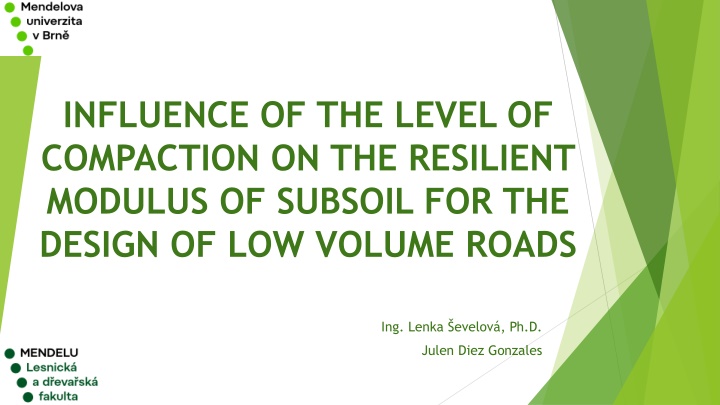
Influence of Compaction Level on Resilient Modulus of Subsoil for Low Volume Roads
Explore the impact of compaction level on road quality and durability through laboratory tests on subsoil materials. Discover how different levels of compaction and moisture content affect the resilient modulus, essential for designing low volume roads.
Download Presentation

Please find below an Image/Link to download the presentation.
The content on the website is provided AS IS for your information and personal use only. It may not be sold, licensed, or shared on other websites without obtaining consent from the author. If you encounter any issues during the download, it is possible that the publisher has removed the file from their server.
You are allowed to download the files provided on this website for personal or commercial use, subject to the condition that they are used lawfully. All files are the property of their respective owners.
The content on the website is provided AS IS for your information and personal use only. It may not be sold, licensed, or shared on other websites without obtaining consent from the author.
E N D
Presentation Transcript
INFLUENCE OF THE LEVEL OF COMPACTION ON THE RESILIENT MODULUS OF SUBSOIL FOR THE DESIGN OF LOW VOLUME ROADS Ing. Lenka evelov , Ph.D. Julen Diez Gonzales
Introduction Low Volume Roads: They are roads in which they have a low frequency of traffic, and at the same time are essential for, the forestry and agricultural economy. These roads also serve to connect communities with a low population and have a great role in recreational activities by making the natural landscapes and protected areas of nature passable. The quality and durability of a road depends on different factors, such us, weather events or human factors. Also, level of compaction given by material density and humidity are important parameters for optimizing the thickness of road construction layers and use less non-renewable resources. CBR Values is essential for this thickness of an LVR layer. In this research cyclic CBR test for obtaining the Resilient Modulus of the material.
Objective To assess the influence of one of the basic properties as humidity and compaction - of a high-quality road. The compaction parameter given by the density is a fundamental characteristic and one basic property. To see the influence of this compaction level and moisture content, the obtained Mr modules determined from test with cyclic loads, are based on research carried out in the laboratories of Mendel University in Brno.
Material And Methods The laboratory analysis consisted of three different geotechnical tests: The classification of subgrade soil materials. Granulometry with aerometry and Atterberg limits. To determine the optimal state of compaction, optimal humidity and maximum dry density Proctor standard test. Determination of the resilience modulus using the cyclical CBR test. Two different CBR cyclic test, developed in in the MENDELU laboratories, with this the MrResilient modulus is obtain.
Results Material Classification (USCS)
Results Amount of cycles for final and real state
Results Resilient Modulus for final and real state
Discussion The analyses carried out showed that the Resilient Module reaches higher values in the case with greater compaction caused by a greater number of cycles. Only in 9% the condition was inverted and the module in a smaller compaction the module was higher. Showed a clear dependence of the Mr,2and Mr,3modules on humidity. They peaked at optimum humidity. With increased moisture growth, the modulus decreased significantly. The number of final cycles was sometimes twenty times greater than the number of actual cycles, the module had no such consequences. The modules have undergone changes of approximately 10 to 20%.
Conclusions The is an influence of the subgrade compaction level on the Resilience Module value. The number of cycles needed to finish the test positively influences the value of the Mrmodule, that is with higher compaction, higher modulus values are obtained, but this value has the maximum value in optimal humidity. The final number of cycles was sometimes twenty times greater than the number of actual cycles, the modulus changed from 15 to 25%. It is necessary to consider the need for the enough cycles and continue with the analysis of the different materials.
